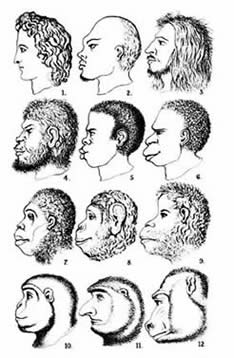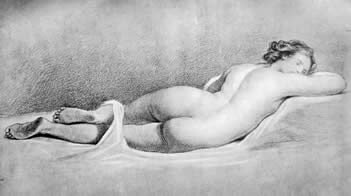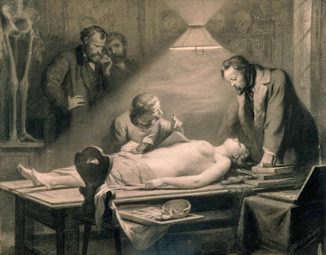Alan W. Bates
London, United Kingdom
Few characteristics seem more subjective and less amenable to scientific study than beauty. As the philosopher David Hume wrote in 1741, “Beauty in things exists in the mind which contemplates them.” How then did some nineteenth-century European anatomists come to see human beauty as a branch of science for which they might construct universal laws?
In the eighteenth-century, the prevalent view was that beauty was an idealization, a human construct inspired by the culture of classical Greece: “frequent occasions of observing Nature, taught the Greeks . . . to form certain general ideas of beauty . . . according to the superior model of some ideal nature.” From standards of “unity and perfection,” acquired by meditating on antiquity, Renaissance artists created works that were a refinement of the “weaker” beauties of nature.1
So while nineteenth-century artists learned anatomy as a matter of course, they did not suppose that merely by getting the anatomy right they could produce great art. The Greeks, it was argued, had created peerless sculptures even though their anatomical knowledge was imperfect,2 and some nineteenth-century critics took a robust line against the anatomical “pedantry” of “dissecting room” art: “Better that a statue should not be quite correct in anatomy, than that it should look like a mummy, and smell of putrefaction.”3
Anatomists and artists were nonetheless dependent on each other; artists mixed with medical students in dissecting rooms and teachers relied on artists to illustrate anatomical textbooks. High quality anatomical illustrations typically combined scientific clarity with a classical aesthetic. For instance, Bernardino Genga’s Anatomia (1691) included illustrations of écorché statues, and the surgeon William Cheselden’s Osteographia (1733) contained engravings of a skeletal Venus de’ Medici and Apollo Belvedere.

Frontispiece from Ernst Haeckel’s Naturliche Schopfungeschichte
Greek statuary represented the ideal of both artistic and anatomical representation. It even influenced the human “racial scale,” illustrated by an ordered skull sequence, which was a commonplace of nineteenth-century anatomy. To a modern observer, the series calls to mind evolutionary development, but it antedated Darwin and was intended to represent a static “chain of being.” Apes were at the bottom of the scale, then Africans, followed by non-European races and, at the top, the classical figure of Apollo, whose beautifully formed head was assumed to correspond to the highest intellectual and moral development.
The link between beauty and moral development prompted some anatomists to advocate the study of beauty before choosing a partner. Kalogynomia, or The Laws of Female Beauty (1821), published under the name of surgeon-anatomist Thomas Bell (1785-1860) but possibly the work of Scottish surgeon John Roberton (1797-1876), provided a concise summary of anatomy and physiology to enable the “gentleman” reader to “purify his taste” and choose true beauty rather than follow his own “selfish” desires. Bell’s ideal was the Venus of classical statuary, “an object finer, Alas! than nature seems even capable of producing.”4
Anatomist Alexander Walker (1779-1852) considered a more functional view of the beauty of Venus. He treated beauty as “a branch of science . . . strictly founded on anatomy and physiology.” Walker described techniques for “judging” female beauty with a view to improving male choices, since “the form of woman . . . is best calculated to ensure attention from men, and because it is men who, exercising the power of selection, have alone the ability thus to insure individual happiness and to ameliorate the species . . .” Walker advised readers contemplating “sexual association” to seek out anatomically correct female beauty because this was their “sole protection against low and degrading connexions.”5
To a modern reader, Walker’s conception of beauty as an agency for improving the species is reminiscent of Darwinian sexual selection. However, Walker envisaged not natural selection but conscious choices based on men’s knowledge of the signification of beauty, which he supposed indicated moral as well as physical superiority. The basis of his thesis, that beauty was linked to fitness for purpose, was extended to animals as well as man; the parts most pleasing to human eyes were those best suited to their proper functions.
The notion that animal beauty was suggestive of proper function was heavily assailed by Irish statesman and author Edmund Burke (1729-97), who wrote that a swine’s snout, a pelican’s bill, and a monkey’s hands were all highly functional yet singularly unattractive, while a “well-fashioned” human mouth or a “well-turned leg” were not well adapted for eating or running.6 Walker, however, countered that the snout possessed the beauty of being ideally suited to its purpose, and though a woman’s mouth was not judged by its fitness for eating, it could “never be seen without suggesting ideas of fitness of some kind or other.”
In 1850, Robert Knox, by then Britain’s most celebrated anatomist, heaped further criticism on Walker’s hypothesis: “why may not a wheelbarrow [be] beautiful? or a pigsty? or a pair of Jack-boots?” As for the human body, a “large, firm, hard, spatula-fingered hand” was, he supposed, far more serviceable than the slender hand of Venus.7 The preceding year, Knox had introduced his own theory of “the Beautiful” in the appendix to his translation of Julien Fau’s The Anatomy of the External Forms of Man:

Burke and Hare, 1921.
Engraving by William Roughead
After a lost drawing by John Oliphant of a body in Knox’s dissecting room posed as Venus, 1828.
The longer I taught anatomy, the more I became convinced that the true signification of external forms was unknown to anatomists and physiologists; now in the discovery of this, is mysteriously wrapped up the whole theory of Art; the knowledge of the Perfect, the Beautiful. I was quite aware that no true theory of the beautiful had ever been submitted to mankind; and that as a consequence the discovery of ‘Nature in Art’ as manifested to us in the antique marbles, was still to be made.8
Knox saw beauty as an indicator of conformity with the ideal type of a species according to the anatomical theory of transcendentalism, of which he was a leading proponent. Transcendentalism’s basic premise was that structural resemblances between species were due to their development from a common type or archetype. According to Goethe, one of transcendentalism’s founding fathers, these archetypes, from which entire classes of living things were derived, were like the theme of “a vast musical symposium.” Where Darwinism would explain similarities as due to common ancestry, transcendentalists saw a common plan.
The embryos of fish, birds, and mammals had long been known to be similar in their early stages. This led transcendentalists to speculate that the embryo could develop into many different forms: “every embryo contains within itself elements sufficient to assume any other form, and to retain it, provided that it be insulated and put under circumstances calculated to bring them forth.” Newly evolved forms normally failed to thrive, but if conditions changed suddenly—for instance, Earth’s revolutions—a new species could appear in a single jump: salutatory evolution. All species within a group had similar anatomies because of their common embryonic origin.
The role of intuition or insight in discerning ideal types provoked criticism that transcendental theories were no more than flights of fancy, and certainly some transcendentalists held quasi-religious, or at least mystical, views of the world. As a scientist, Knox saw that aesthetic judgments could be used only if they were shown to be objective. In his popular work The Races of Men, he rationalized beauty as a surrogate indicator of health: “In proportion as any figure, whether human or bestial, displays through the exterior, that unseemly interior, which has no form that sense comprehends, or desires, so in the same proportion is that figure beautiful or the opposite.” Beauty was, according to Knox, literally skin deep. The most displeasing human forms were those of old age and infirmity: frail, emaciated, skeletal figures were less attractive than rounded, “juicy,” well-fleshed ones because they exposed “that dreaded interior, sure emblem of dissolution and death.”9

Engraving, after a chalk drawing by J. H. Hasselhorst, 1864.
From the author’s collection.
Knox agreed with Bell and Walker that Venus was “the perfect human figure.” Because “not a trace of anatomy, of muscle, tendon, or vein is to be seen,” she embodied the fullness of health, and in her, he argued, artists had unknowingly represented the ideal type of the species. Aesthetically, Knox considered the female superior to the male, and the adult to the infant. Infantile forms lacked adult beauty because they revealed the embryo’s potential to produce “imperfectly developed forms” that reflected man’s kinship with “lower forms of the organic world.” This explained why “great artists avoided painting or sculpting new-born children, or even those a few days old. They were aware, although they knew not the reason, that such forms were not strictly human.”10
Knox entertained the possibility of a mathematical basis for human beauty, “a deep geometry, which the correct mind searches for,” and, had the failure of his anatomy school not deprived him of access to cadavers, he might have followed the example of Frankfurt anatomist Johann Lucae (1814-85), who dissected a beautiful woman in order to establish the correct anatomical proportions. As it was, Knox’s mature works remained speculative, and he abandoned his attempts to formulate a theory of species change after the appearance of The Origin of Species in 1859.
When Darwin turned his attention to the role of beauty in sexual selection in 1871, nine years after Knox’s death, he favored the view that human beauty was dependent upon arbitrary cultural conventions.11 By rejecting claims for a universal standard of beauty, perhaps because he relied on judgments made by missionaries about the “primitive” people they studied, he seems to have discouraged further scientific studies of human beauty for over a century. Recent research12,13 has, however, furnished evidence that human beauty may indeed conform to universal, cross-cultural standards. Moreover, it appears likely that Darwinian sexual selection is driven by preferences for cues that reveal health, while what Knox termed the ideal type of a species has been reinterpreted as prototypicality: the perception of beauty in average forms that are perceived as familiar and safe.13 Though Knoxian transcendentalism has been largely forgotten since Darwin, its focus on aesthetics can be seen in retrospect as a significant, if characteristically quixotic, contribution to evolutionary theory.
References
- Winckelmann JJ. Reflections on the Painting and Sculpture of the Greeks. Fusseli H, translator. London: for the Translator; 1765.
- Flaxman J. Essays on Sculpture. Edin Rev 1829-30; 50: 231-55.
- “Ignoramus.” Blackwood’s 1831; 29: 214-23.
- Bell T. Kalogynomia, or the Laws of Female Beauty. London: JJ Stockdale; 1821, pp. 5-6, 74.
- Walker A. Beauty: Illustrated Chiefly by an Analysis and Classification of Beauty in Woman. London: Effingham Wilson; 1836, pp. vii, 12–13, 17, 20, 150.
- Burke E. The Works of the Right Hon. Edmund Burke. 2 vols. London: Holdsworth and Ball; 1834, vol. 1, pp. 52–3.
- Knox R. The Races of Men: a Fragment. London: Henry Renshaw; 1850, p. 276.
- Fau J. The Anatomy of the External Forms of Man. Knox R, editor. London: Hippolyte Baillière; 1849, pp. x-xi.
- Knox R. A Manual of Artistic Anatomy. London: Henry Renshaw; 1852, pp. 78–9, 126, 170–1.
- Knox, op. cit. 1850, p. 277.
- Darwin C. The Descent of Man, and Selection in Relation to Sex. 2 vols. London: John Murray; 1871, vol. 2, pp. 316-54.
- Thornhill R, Grammer K. The Body and Face of Woman: One Ornament that Signals Quality? Evol Hum Behav 1999; 20: 105-20.
- Grammer K, Fink B, Møller AP, Thornhill R. Darwinian Aesthetics: Sexual Selection and the Biology of Beauty. Biol Rev Camb Phil Soc 2003; 78:385-407.
ALAN W. BATES, MD, PhD, FRCPath, is Honorary Senior Lecturer in Pathology at University College London and an honorary consultant at University College Hospital. He is the author of Emblematic Monsters (Rodopi 2005) and The Anatomy of Robert Knox (Sussex Academic Press 2010).
Highlighted in Frontispiece Volume 3, Issue 1 – Winter 2011

Leave a Reply